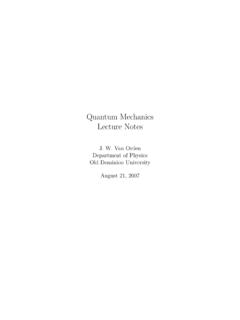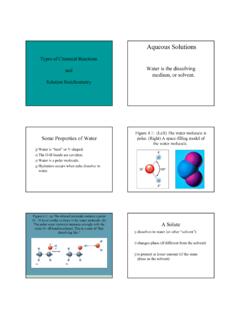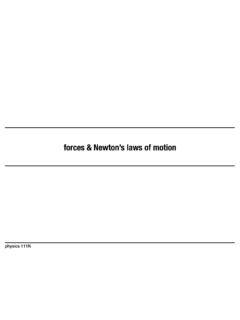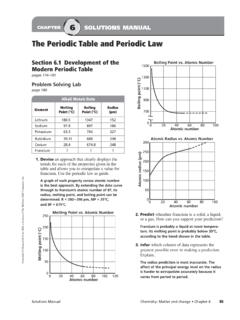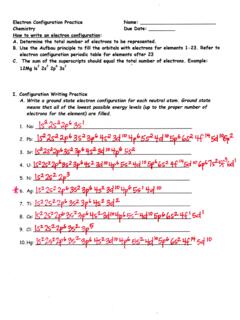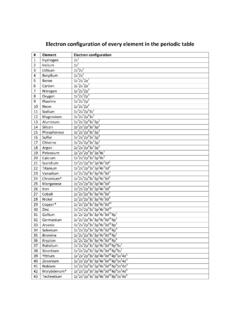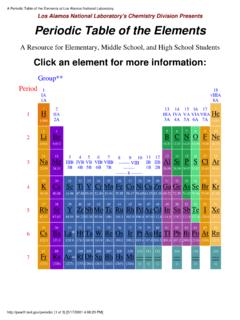Transcription of Bond Length - Old Dominion University
1 Bonds Chapter 8. Forces that hold groups of Bonding: atoms together and make them function as a unit. General Concepts Bond Energy Bond Length Itis the energy required to break a The distance where the bond. system energy is a minimum. It gives us information about the strength of a bonding interaction. 1. Figure : (a) The interaction of two hydrogen atoms. (b) Energy profile as a function of the distance between the nuclei of Covalent Bonds the hydrogen atoms. When two nonmetals bond, they often share electrons since they have similar attractions for them.
2 This sharing of valence electrons is called the covalent bond. These atoms will share sufficient numbers of electrons in order to achieve a noble gas electron configuration (that is, eight valence electrons). Polar Covalent Bonds Polar Covalent Bonds A polar covalent bond is one in which the Electronegativity is a measure of the bonding electrons spend more time near one ability of an atom in a molecule to draw of the two atoms involved. bonding electrons to itself. When the atoms are alike, as in the H-H bond In general, electronegativity increases from the of H2 , the bonding electrons are shared equally lower-left corner to the upper-right corner of (a nonpolar covalent bond).
3 The periodic table . When the two atoms are of different elements, The current electronegativity scale, developed the bonding electrons need not be shared by Linus Pauling, assigns a value of to equally, resulting in a polar bond. fluorine and a value of to cesium. 2. Figure : The Pauling electronegativity Electronegativity values. Electronegativity generally increases across a period and decreases down a group. The ability of an atom in a molecule to attract shared electrons to itself. Calculated using difference between experimental bond energy and expected bond energy = (H X)actual (H X)expected For the C=O bond: - = electronegativity difference Expected H-X bond energy = H-H + X-X 2.
4 Figure : The three possible types of bonds (a) a covalent bond formed between identical atoms (b) a polar covalent bond, with both ionic and covalent components; and (c) an ionic bond with no electron sharing. 3. Figure : The relationship between the ionic Polar Covalent Bonds character of a covalent bond and the electronegativity difference of the bonded atoms. The absolute value of the difference in electronegativity of two bonded atoms gives a rough measure of the polarity of the bond. When this difference is small (less than ), the bond is nonpolar.
5 When this difference is large (greater than ), the bond is considered polar. If the difference exceeds approximately , sharing of electrons is no longer possible and the bond becomes ionic. Figure : The effect of an electric field on hydrogen fluoride Polarity molecules. (a) When no electric field is present, the molecules are randomly oriented. (b) When the field is turned on, the molecules tend to line up with their negative ends toward the positive pole and their A molecule, such as HF, that has a positive ends toward the negative pole.
6 Center of positive charge and a center of negative charge is said to be polar, or to have a dipole moment. H F. + . 4. Figure : The HCl molecule. Polar Covalent Bonds For example, the bond between carbon and oxygen in CO2 is considered polar because the shared electrons spend more time orbiting the oxygen atoms. +. : : : : O C O . The result is a partial negative charge on the oxygens (denoted ) and a partial positive - = charge on the carbon (denoted +). The C=O. Bond is polar covalent - and the HCl molecule is also polar bond is polar - but the molecule is not.
7 Figure : (a) The carbon dioxide molecule. Figure : (a) The charge distribution (b) The opposed bond polarities cancel out, and the carbon dioxide has no dipole moment. in the water molecule. (b) The water molecule in an electric field. 5. Figure : (a) The structure and charge distribution of the ammonia molecule. The polarity of the N H. bonds occurs because nitrogen has a greater electronegativity than hydrogen. (b) The dipole moment of the ammonia molecule oriented in an electric field. Ionic Bonds Ionic Bonds Formed from electrostatic attractions of E = 10 19 J nm (Q1Q2 / r ).
8 Closely packed, oppositely charged ions. Formed when an atom that easily loses electrons reacts with one that has a high Q1 and Q2 = numerical ion charges electron affinity. r = distance between ion centers (in nm). 6. Valence Electrons - an electron in an atom Achieving Noble Gas electron outside the noble gas or pseudo-noble gas Configurations (NGEC). core. Pseudo-noble gas core: refers to the noble gas + (n-1)d10 configura- Two nonmetals react: They share tion. Example: As has configuration electrons to achieve NGEC.
9 [Ar]3d104s24p3 and has 5 valence electrons A nonmetal and a representative group metal react (ionic compound): The valence Ionic Bonds - a chemical bond formed by orbitals of the metal are emptied to achieve the electrostatic attraction between positive NGEC. The valence electron configuration and negative ions of the nonmetal achieves NGEC. electron Configurations of Ions As metals lose electrons to form cations and establish a noble gas configuration, the electrons are lost from the valence shell first.
10 For example, magnesium generally loses two electrons from its 3s subshell to look like neon. Mg Mg 2+ ( +2 e - ). [Ne]3s2 [Ne]. 7. Isoelectronic Ions electron Configurations of Ions Transition metals also lose electrons from the Ions containing the the same number of valence shell first, which is not the last subshell to electrons fill according to the aufbau sequence. For example, zinc generally loses two electrons (O2 , F , Na+, Mg2+, Al3+). from its 4s subshell to adopt a pseudo -noble gas configuration.



